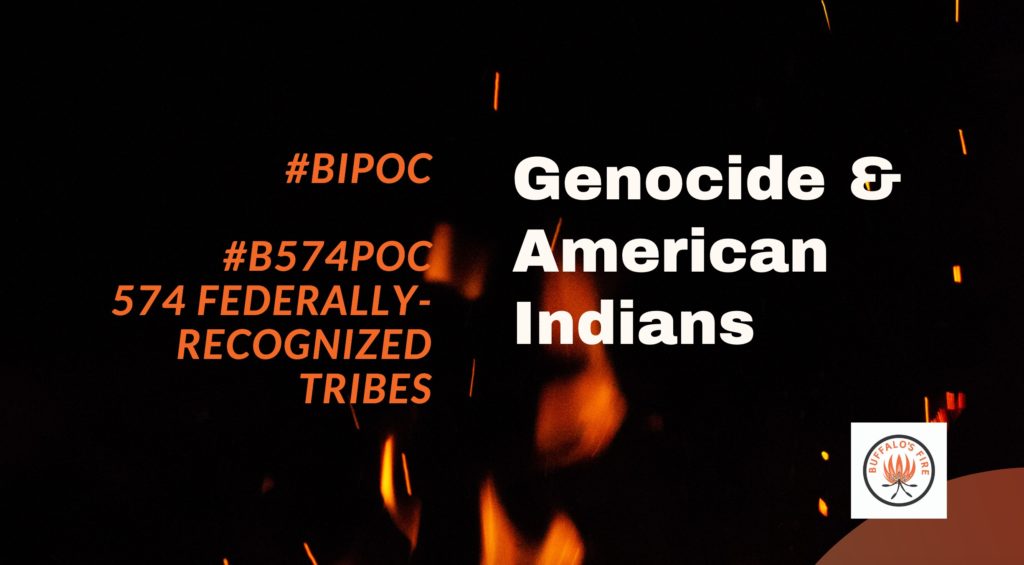By Jodi Rave
Buffalo’s Fire
If you are in a position to present on Diversity, Equity and Inclusion, please be clear about your material. If your lens only captures black and white images, say it up front. I’ve worked in the mainstream press and, now, in non-profit media. I’ve long been aware that Indigenous peoples tend to fall off data and news radar systems.
It’s why Native people are often referred to as the invisible race in America. It’s one of the reasons the “I” was put in BIPOC – Black, Indigenous, People of Color –acronym. The intent was to remember us. So, when a national organization invited news groups to a webinar on Diversity, Equity and Inclusion, I signed up.
I felt the need to listen to the words of an ally. What messages might I take away to help others? What can news organizations do to help lift the veil on Indigenous peoples?
“The discovery of America was followed by possibly the greatest demographic disaster in the history of the world.”
-William M. Denevan in “The Native Population of the Americas in 1492”
Unfortunately, this would not be an inclusive DEI webinar. It mainly highlighted the disparities of a Black and White world. I sent a direct message to the Zoom diversity panelists to ask if we might expect to learn anything about Native issues. The answer was basically, no.
The presenter’s reply – not just to me but the whole group – was that there were only two million American Indians – four million if you count biracial Natives. Such paltry numbers can hardly be included in a meaningful, statistically-driven discussion. So, let’s just stick to comparing Fuji apples to Fuji apples.
I left before the well-intended Diversity, Equity and Inclusion webinar ended.
So, why are there only two million American Indians in the 21st Century? Fact check: The 2010 Decennial Census shows there are actually 2.9 million American Indian and Alaskan Natives and 5.2 million biracial Natives. Every million counts, especially when there are so few of us. But, we didn’t always have such low population numbers. We are the survivors of genocide.
“The Great Dying of the Indigenous Peoples of the Americas resulted in a human-driven global impact on the Earth System in the two centuries prior to the Industrial Revolution.”
-a 2019 study published in the Quarternary Science Reviews
When Christopher Columbus landed in the Caribbean, the Indigenous population in the Americas was estimated at about 60 million. After torturing, killing, introducing diseases and stealing Indigenous lands, America’s Indigenous populations plummeted. “The discovery of America was followed by possibly the greatest demographic disaster in the history of the world,” writes William M. Denevan in “The Native Population of the Americas in 1492.”
“The Great Dying of the Indigenous Peoples of the Americas resulted in a human-driven global impact on the Earth System in the two centuries prior to the Industrial Revolution,” according to a 2019 study published in the Quarternary Science Reviews. After Columbus’s arrival, an estimated 90 percent of Indigenous people in the Americas died within 100 years.
The 1948 Genocide Convention identifies genocide as committing at least one of five acts “with the intent to destroy, in whole or in part, a national, ethnical, racial or religious group.” Indigenous people experienced all five criteria, including death through starvation, bodily and mental harm, deliberate inflictions to destroy us, the sterilization of Native women by the Indian Health Service, sending children to boarding schools to be acculturated, and the removal of Indigenous children from nuclear and extended families to be adopted by non-Native families.
“I can still see the butchered women and children lying heaped and scattered all along the crooked gulch as plain as when I saw them with eyes still young. And I can see that something else died there in the bloody mud, and was buried in the blizzard. A people’s dream died there. It was a beautiful dream . . . the nation’s hoop is broken and scattered.”
-Black Elk, the holy man of the Oglala Lakota
Black Elk, the holy man of the Oglala Lakota, reminds us what the intent to destroy looks like: “I can still see the butchered women and children lying heaped and scattered all along the crooked gulch as plain as when I saw them with eyes still young. And I can see that something else died there in the bloody mud, and was buried in the blizzard. A people’s dream died there. It was a beautiful dream . . . the nation’s hoop is broken and scattered.”
It’s much easier to render Indigenous people as invisible than to own up to genocide. The Quarternary study shows the Indigenous population in North America reached a low of 490,000 in the 1930s. Despite centuries of genocidal practices the population numbers of 574-federally recognized tribes are on the rise. Expect to see an increase in the number of people who identify as Native in the new 2020 census.
We are resilient. Some might argue the “I” in BIPOC doesn’t do enough to recognize the diversity of Native peoples. Perhaps a more inclusive acronym would be #B574POC. Indigenous people might not have the type numbers that fit nicely into a national data chart about Diversity, Equity and Inclusion, but, what’s more important for a presentation, data or consciousness?

